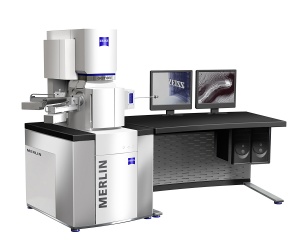Today Carl Zeiss announces a series of launches covering a range of product and application innovations. The start of this series is marked by the next-generation analytical field emission scanning electron microscope - the MERLIN™. This instrument combines the up to now contradictory requirements of ultra-high resolution imaging and analytical capabilities. "Customers have a need for more than just high resolution images of their samples", Dr. Dirk Stenkamp, Member of the Board at Carl Zeiss SMT explains. "With unique analytical capabilities our instruments provide maximum information with maximum insight".
 A key aspect of the new FE-SEM MERLIN™ from Carl Zeiss is ease of use, for example in-situ sample cleaning, unique charge compensation or image acquisition in less than one minute.
A key aspect of the new FE-SEM MERLIN™ from Carl Zeiss is ease of use, for example in-situ sample cleaning, unique charge compensation or image acquisition in less than one minute.
MERLIN™ – analysis and high resolution in one
The MERLIN FE-SEM overcomes the conflict between image resolution and analytical capability. The core of MERLIN is the enhanced GEMINI II column which, with its double condenser system, achieves an image resolution of 0.8 nanometers. A sample current of up to 300 nanoamperes is available for analytical purposes such as energy and wavelength dispersive X-ray spectroscopy (EDS and WDS), diffraction analysis of backscattered electrons (EBSD) or the generation of cathodoluminescence.
The system supports the user with a wide range of detailed solutions for tasks that could not be adequately performed in the past. The foundation for this achievement has been laid by the Carl Zeiss "Complete Detection System". This consists of the in-lens SE detector for surface imaging, the in-lens EsB detector for material contrast and the AsB detector for widely dispersed backscattered electrons. The latter contain specific information on the crystal orientation of the sample.
The unique charge compensation system of MERLIN also allows the high-resolution imaging of non-conductive samples. Electrons which accumulate on the surface of the sample are swept away by a fine jet of nitrogen. In doing so, the complete detection system of MERLIN can be used. An additional feature of the system for charge compensation is a channel for pure oxygen enabling in-situ sample cleaning. Within the vacuum chamber frequently occurring carbon deposits are removed from the sample surface, thus producing a significantly crisper and contrasty image. Both options allow the user to concentrate on the imaging and analysis of the sample instead of investing time and money in sample preparation.
MERLIN’s new electronic system permits a flexible instrument configuration. Additional detectors can be retrofitted quickly, allowing the user to adapt the system to growing requirements. In addition, this flexibility makes the investment more future-proof and enables the user to benefit over the long term from ongoing detector development.
"The new MERLIN, as well as the just recently introduced AURIGA CrossBeam workstation perfectly embody what our products stand for: Maximum Information – Maximum Insight", Stenkamp points out. "And – the market can expect much more in the coming weeks until M&M show and the European Microscopy Conference in Graz, Austria, end of August."